Investigation of Ultrasonic Velocity and Transmission Losses in Graphite Rods Based on Numerical Simulation and Experiment
Abstract
:1. Introduction
- (1)
- We proposed an ultrasonic non-destructive measurement method for consumable electrode length;
- (2)
- We developed a FEM model which is based on the successful ultrasonic measurement results.
2. Theoretical Background
2.1. Electrode System of Submerged Arc Furnaces
2.2. Ultrasonic Non-Destructive Measurement Method for Consumable Electrodes
3. Experimental Setup and FEM Theory
3.1. Experimental Set-Up
- (1)
- Different modes had different degrees of dispersion. The same mode had different degrees of dispersion in different frequency ranges;
- (2)
- The phase velocity of the T (0, 1) mode was frequency-independent, which indicates that the T (0, 1) mode was a non-dispersive mode;
- (3)
- Near the cutoff frequency of the L (0, 1) longitudinal mode, there was a frequency range with a small degree of dispersion, and the L (0, 1) mode had the largest group velocity in this frequency range. In summary, the group velocity of the L (0, 1) mode was larger than that of other modes in the range of its low-frequency dispersion frequency. This means that the L (0, 1) mode signal will reach the transducer first.
3.2. Graphite Rod Sample
3.3. Layout of the FEM Model
4. Results and Discussions
4.1. Experimental Measurement Results
4.2. Numerical Simulation Results
5. Conclusions
6. Further Work
Author Contributions
Funding
Institutional Review Board Statement
Informed Consent Statement
Data Availability Statement
Conflicts of Interest
Appendix A. The Propagation of Elastic Waves in the Rod
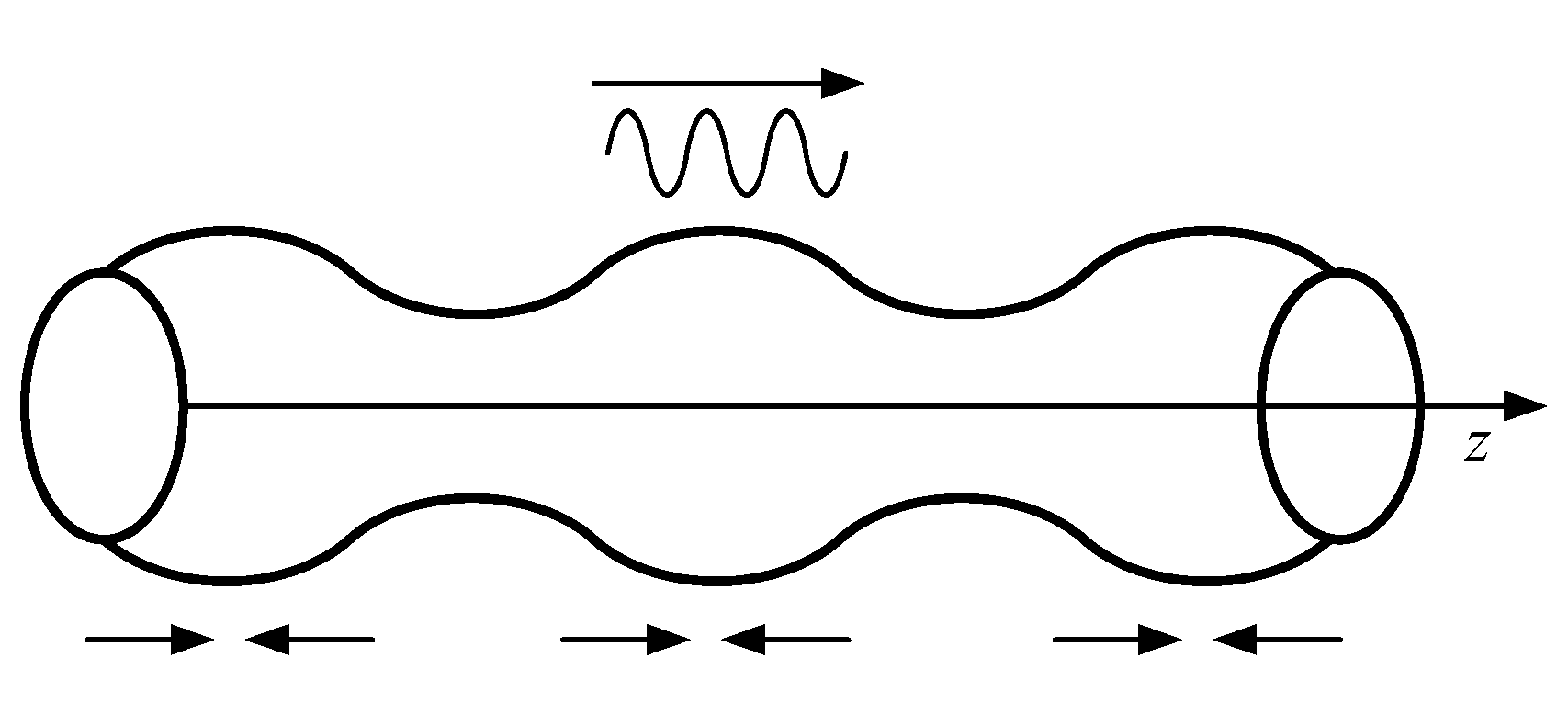
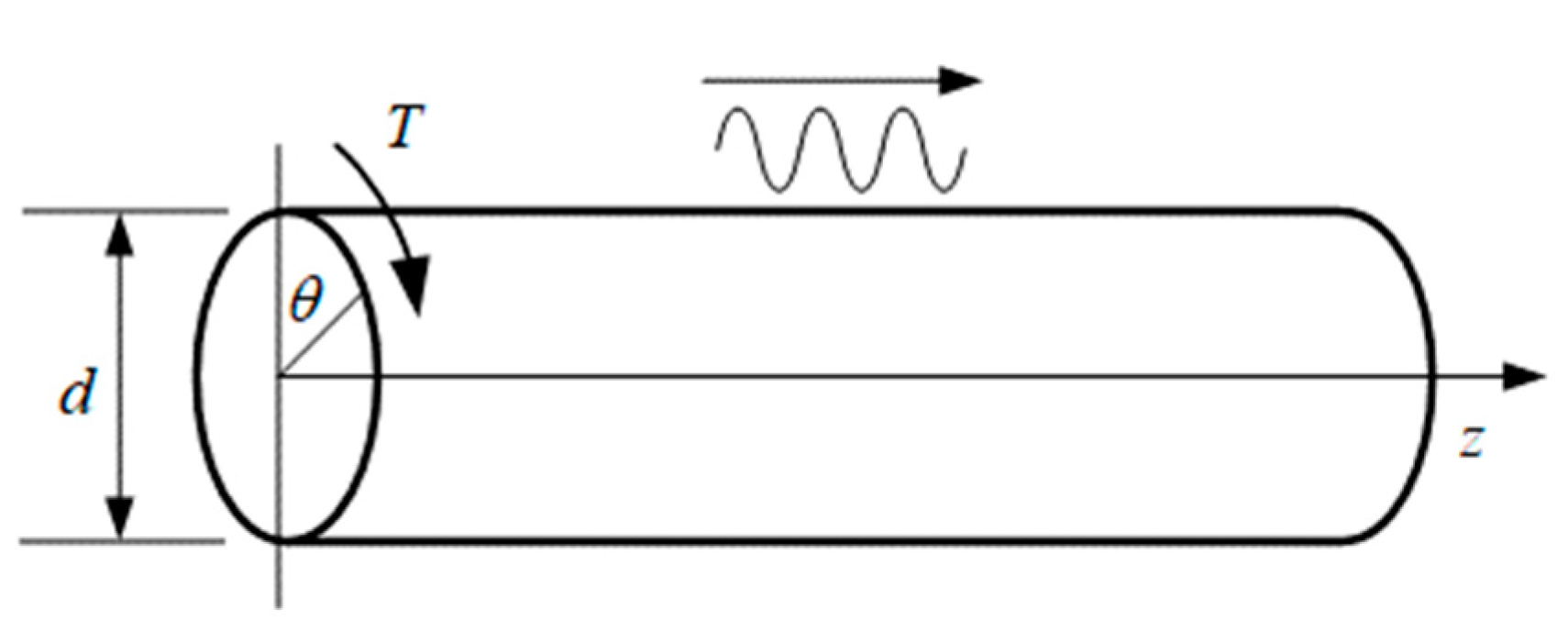

References
- He, J.-J.; Liu, Y.-q.; Yu, S.-y.; Gui, W.-h. Neural adaptive PSD decoupling controller and its application in three-phase electrode adjusting system of submerged arc furnace. J. Cent. South Univ. 2013, 20, 405–412. [Google Scholar] [CrossRef]
- Karalis, K.T.; Karkalos, N.; Cheimarios, N.; Antipas, G.; Xenidis, A.; Boudouvis, A. A CFD analysis of slag properties, electrode shape and immersion depth effects on electric submerged arc furnace heating in ferronickel processing. Appl. Math. Model. 2016, 40, 9052–9066. [Google Scholar] [CrossRef]
- Liu, W.; Yang, L.; Chang, X. Detection for Position of Electrode Tip of Submerged Arc Furnaces with the Differential Magnetic Field Radiation. J. Magn. 2020, 25, 78–85. [Google Scholar] [CrossRef]
- Melgaard, D.K.; Beaman, J.J.; Shelmidine, G.J. Electrode Immersion Depth Determination and Control in Electroslag Remelting Furnace. U.S. Patent 7,180,931, 20 February 2007. [Google Scholar]
- Roberts, R.J. Method and Apparatus for Controlling Electrode Drive Speed in a Consumable Electrode Furnace. U.S. Patent 4,303,797, 1 December 1981. [Google Scholar]
- Patrick, J.F.; Niese, U.R. A method for determining the position of the tip of an electric arc furnace electrode, in particular a Söderberg electrode. D.E. Patent 102016219261, 5 October 2016. [Google Scholar]
- Liu, W.L.; Chang, X.M. A Non-contact Detection Method for Smelting in Submerged Arc Furnace based on Magnetic Field Radiation. J. Magn. 2016, 21, 204–208. [Google Scholar] [CrossRef] [Green Version]
- Liu, W.; Han, X.; Yang, L.; Chang, X. Array Sensing Using Electromagnetic Method for Detection of Smelting in Submerged Arc Furnaces. J. Magn. 2016, 21, 322–329. [Google Scholar] [CrossRef] [Green Version]
- Dienenthal, J.; Morgenstern, H.U. Method and apparatus for length measurement at an electrode. EP Patent 2594112, 1 June 2010. [Google Scholar]
- Jiang, T.; Kong, Q.; Patil, D.; Luo, Z.; Huo, L.; Song, G. Detection of Debonding Between Fiber Reinforced Polymer Bar and Concrete Structure Using Piezoceramic Transducers and Wavelet Packet Analysis. IEEE Sens. J. 2017, 17, 1992–1998. [Google Scholar] [CrossRef]
- Niles, G.B. In Situ Method of Inspecting Anchor Rods for Section Loss Using the Cylindrically Guided Wave Technique. IEEE Trans. Power Deliv. 1996, 11, 1601–1605. [Google Scholar] [CrossRef]
- Li, M.; He, J.J. Effect of high temperature on ultrasonic velocity in graphite. Diam. Relat. Mater. 2021, 116, 108368. [Google Scholar] [CrossRef]
- Dubey, P.K.; Rajagopalan, S.; Vyaghra, V.R.; Pendsey, V.M.; Sharma, S.J. Hight resolution ultrasonic attenuation measurement in pulse-echo setup. MAPAN J. Metrol. Soc. India 2008, 23, 245–252. [Google Scholar]
- Sears, F.M.; Bonner, B.P. Ultrasonic attenuation measurement by spectral ratios utilizing signal processing techniques. IEEE Trans. Geosci. Remote Sens. 1981, GE-19, 95–99. [Google Scholar] [CrossRef]
- Moser, F.; Jacobs, L.J.; Qu, J. Modeling elastic wave propagation in waveguides with the finite element method. NDT E Int. 1999, 32, 225–234. [Google Scholar] [CrossRef]
- Seco, F.; Jiménez, A.R. Modelling the generation and propagation of ultrasonic signals in cylindrical waveguides. In Ultrasonic Waves; IntechOpen: Rijeka, Croatia, 2012; pp. 1–28. [Google Scholar]
- Puthillath, P.; Galan, J.M.; Ren, B.; Lissenden, C.J.; Rose, J. Ultrasonic guided wave propagation across waveguide transitions: Energy transfer and mode conversion. J. Acoust. Soc. Am. 2013, 133, 2624. [Google Scholar] [CrossRef] [PubMed]
- Jankauskas, A.; Mazeika, L. Ultrasonic guided wave propagation through welded lap joints. Metals 2016, 6, 315. [Google Scholar] [CrossRef] [Green Version]
- Habiba, L.; Lowe, P.S.; Gan, T.H.; Wrobel, L.C. Numerical Modelling of Acoustic Pressure Fields to Optimize the Ultrasonic Cleaning Technique for Cylinders. Ultrason. Sonochem. 2018, 45, 7–16. [Google Scholar]
- Habiba, L.; Lowe, P.S.; Gan, T.H.; Wrobel, L.C. Numerical investigation of design parameters for optimization of the in-situ ultrasonic fouling removal technique for pipelines. Ultrason. Sonochem. 2019, 56, 94–104. [Google Scholar]
- Zima, B.; Rucka, M. Guided ultrasonic waves for detection of debonding in bars partially embedded in grout. Constr. Build. Mater. 2018, 168, 124–142. [Google Scholar] [CrossRef]
- Yu, T.; Chaix, J.-F.; Audibert, L.; Komatitsch, D.; Garnier, V.; Hénault, J.-M. Simulations of ultrasonic wave propagation in concrete based on a two-dimensional numerical model validated analytically and experimentally. Ultrasonics 2018, 92, 21–34. [Google Scholar] [CrossRef]
- Diaz, J.J.D.C.; Alvarez Rabanal, F.P.; Nieto, P.J.G.; López, M.S. Sound transmission loss analysis through a multilayer lightweight concrete hollow brick wall by FEM and experimental validation. Build. Environ. 2010, 45, 2373–2386. [Google Scholar] [CrossRef]
- Halvorsen, S.A.; Olsen, H.A.H.; Fromreide, M. An Efficient Simulation Method for Current and Power distribution in 3-Phase Electrical Smelting Furnaces. IFAC Pap. 2016, 49, 167–172. [Google Scholar] [CrossRef]
- Liu, W.; Han, X.; Yang, L.; Chang, X. Array Sensing Using Differential Magnetic Field Method for Electrode Tip Position of Submerged Arc Furnaces. J. Magn. 2021, 26, 101–110. [Google Scholar] [CrossRef]
- Beukes, J.; Roos, H.; Shoko, L.; Van Zyl, P.; Neomagus, H.; Strydom, C.; Dawson, N. The use of thermomechanical analysis to characterise Söderberg electrode paste raw material. Miner. Eng. 2013, 46, 167–176. [Google Scholar] [CrossRef]
- Mason, W.P. Attenuation and Scattering of High Frequency Sound Waves in Metals and Glasses. J. Acoust. Soc. Am. 1947, 19, 725. [Google Scholar] [CrossRef] [Green Version]
- Ivanovi, A.; Neilson, R.D. Non-destructive testing of rock bolts for estimating total bolt length. Int. J. Rock Mech. Min. Sci. 2013, 64, 36–43. [Google Scholar] [CrossRef]
- Hayashi, T.; Inoue, D. Calculation of leaky Lamb waves with a semi-analytical finite element method. Ultrasonics 2014, 54, 1460–1469. [Google Scholar] [CrossRef] [PubMed]
- Lu, P.; Zhong, L.M.J. The quality evaluation system of graphite electrode. Carbon Tech. 2021, 1, 62–64. [Google Scholar]
- Method for Measurement of Ultrasonic Attenuation Coefficient of Solids. JIS Z2354-2012.2012-01-20. Available online: https://www.antpedia.com/standard/6287432.html (accessed on 20 January 2012).
- Hu, W.Q.; Wang, M.Q.; Liu, Z.H. Study on the design of free damping structure specimen by cantilever beam bending resonance method. J. Exp. Mech. 2008, 23, 241–247. [Google Scholar]
- Kolsky, H. Stress Waves in Solids; Dover Publications, Inc.: New York, NY, USA, 1963. [Google Scholar]
- Pochhammer, L.A.; Biegung, D. Circular Cylinder Reproduction Speed Small Vibrations in a Circular Cylinder. Mathematics 1876, 1, 326–336. [Google Scholar]
- Graff, K.F. Wave Motion in Elastic Solids; Courier Corporation: North Chelmsford, MA, USA, 2012. [Google Scholar]
- Pao, Y.-H.; Mindlin, R. Dispersion of Flexural Waves in an Elastic, Circular Cylinder. J. Appl. Mech. 1960, 27, 513–520. [Google Scholar] [CrossRef]
- Pao, Y.-H. Dispersion of Flexural Waves in an Elastic Circular Cylinder, Part II; Department of Civil Engineering and Engineering Mechanics, Columbia University: New York, NY, USA, 1960. [Google Scholar]
- Kumar, R. The Dispersion of Flexural Waves in an Elastic Circular Cylinder. J. Appl. Mech. 1972, 39, 817–819. [Google Scholar] [CrossRef]




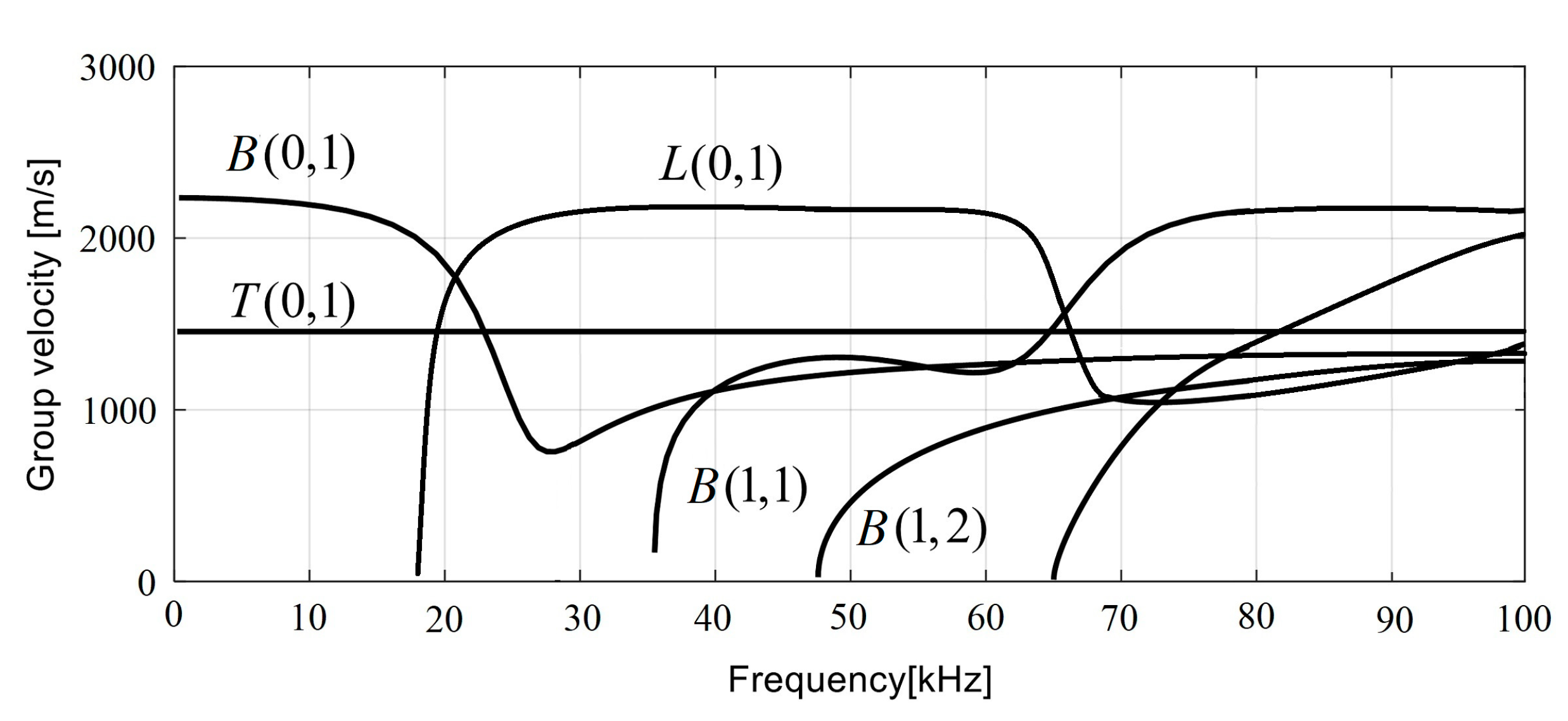

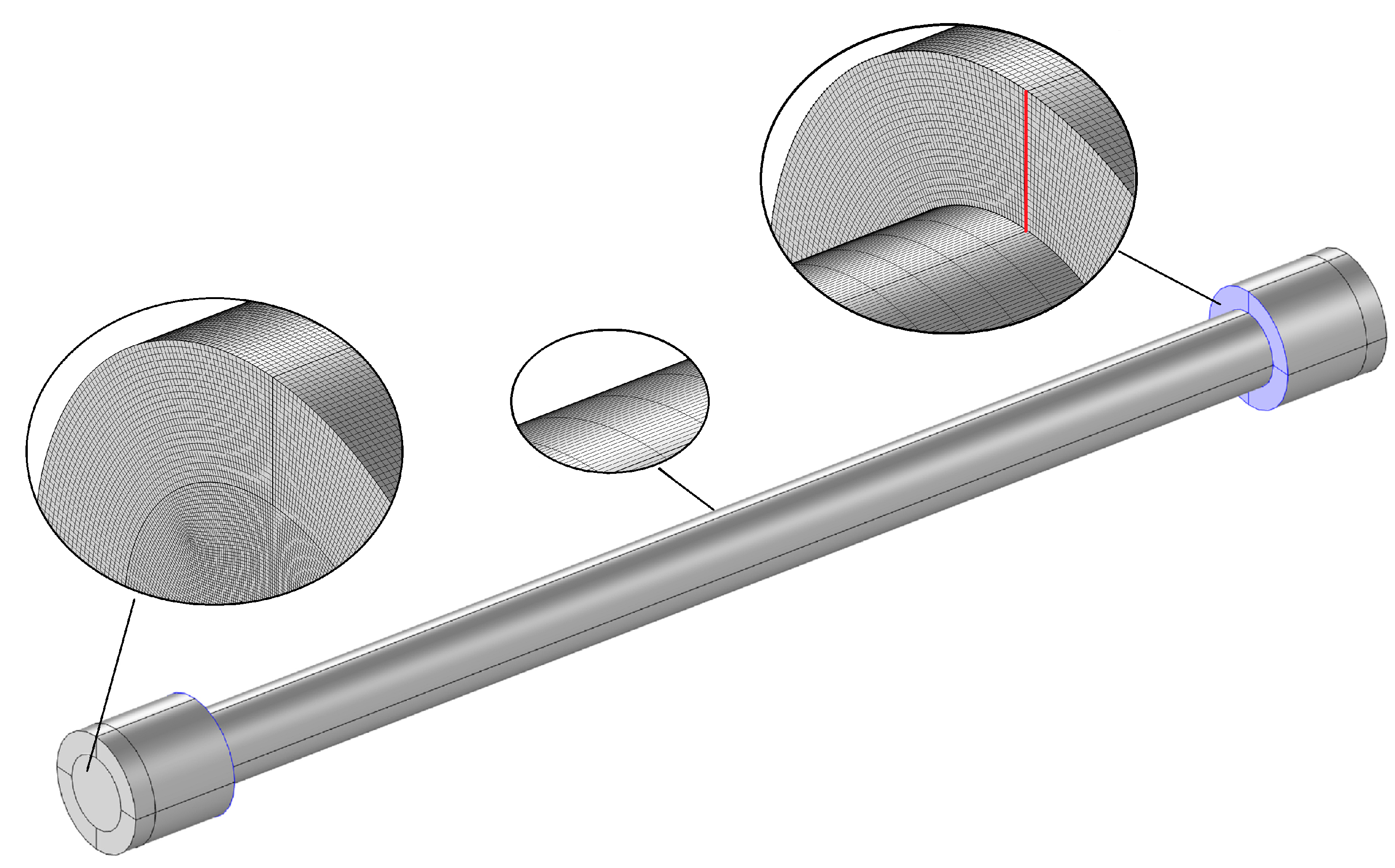


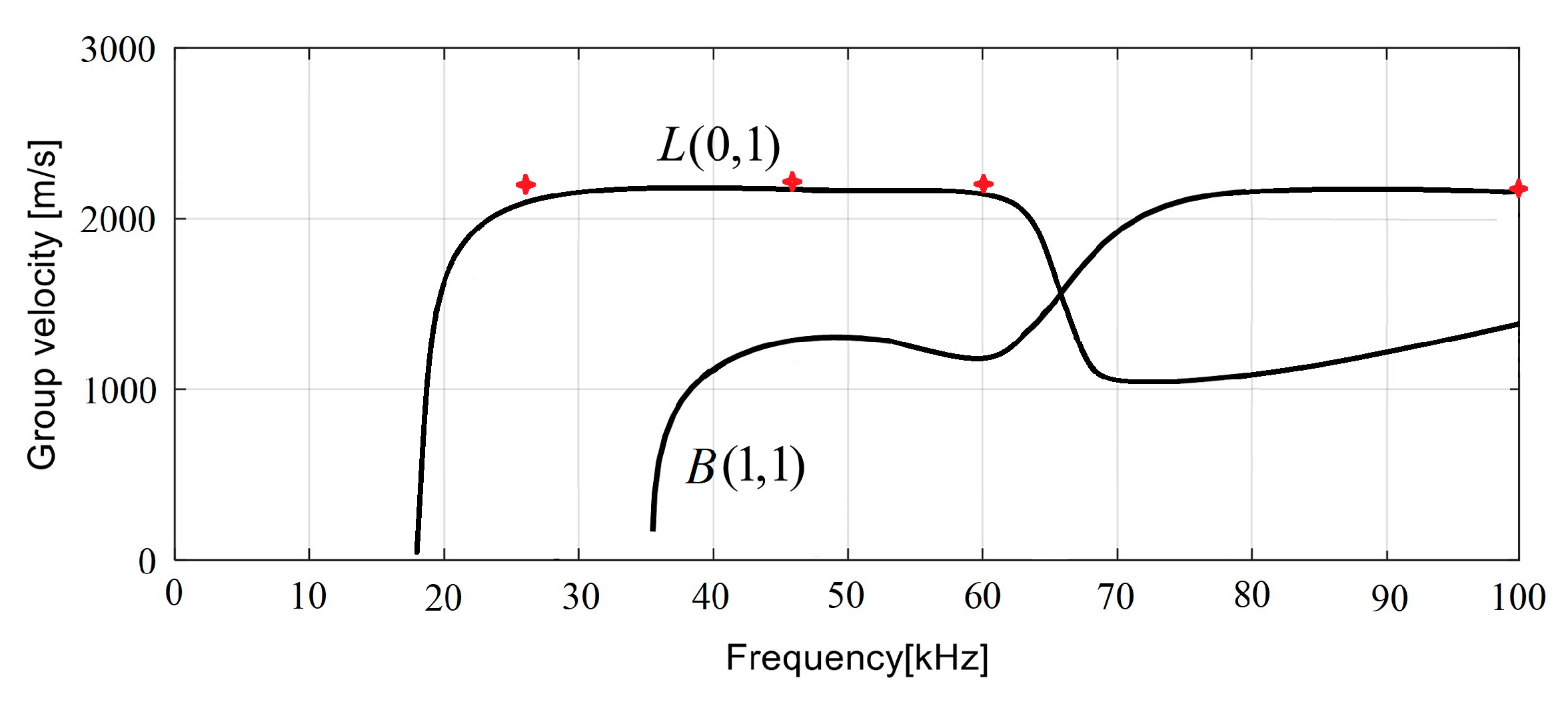


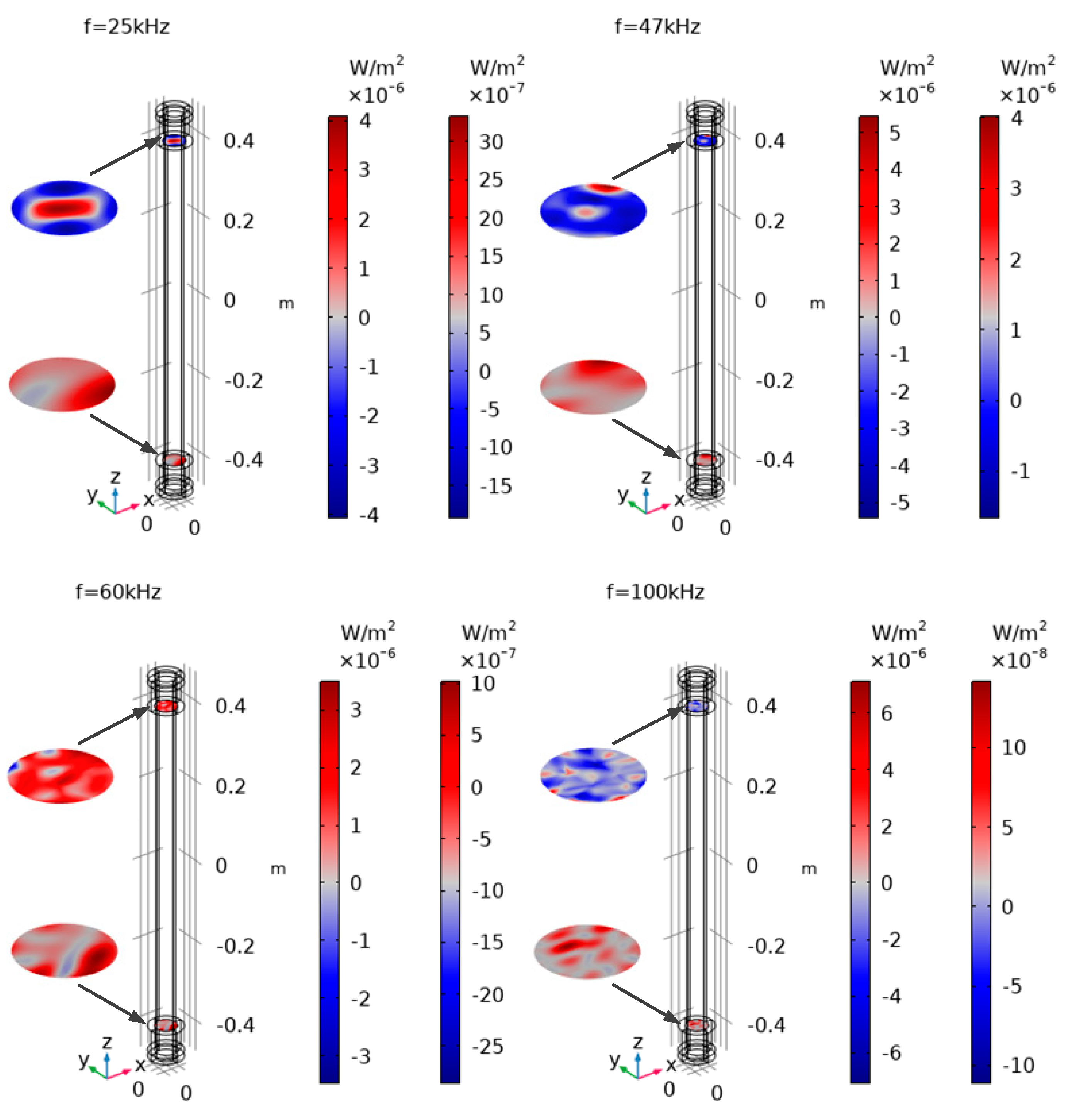

Disclaimer/Publisher’s Note: The statements, opinions and data contained in all publications are solely those of the individual author(s) and contributor(s) and not of MDPI and/or the editor(s). MDPI and/or the editor(s) disclaim responsibility for any injury to people or property resulting from any ideas, methods, instructions or products referred to in the content. |
© 2023 by the authors. Licensee MDPI, Basel, Switzerland. This article is an open access article distributed under the terms and conditions of the Creative Commons Attribution (CC BY) license (https://creativecommons.org/licenses/by/4.0/).
Share and Cite
Li, M.; He, J. Investigation of Ultrasonic Velocity and Transmission Losses in Graphite Rods Based on Numerical Simulation and Experiment. Appl. Sci. 2023, 13, 3329. https://doi.org/10.3390/app13053329
Li M, He J. Investigation of Ultrasonic Velocity and Transmission Losses in Graphite Rods Based on Numerical Simulation and Experiment. Applied Sciences. 2023; 13(5):3329. https://doi.org/10.3390/app13053329
Chicago/Turabian StyleLi, Mi, and Jianjun He. 2023. "Investigation of Ultrasonic Velocity and Transmission Losses in Graphite Rods Based on Numerical Simulation and Experiment" Applied Sciences 13, no. 5: 3329. https://doi.org/10.3390/app13053329




